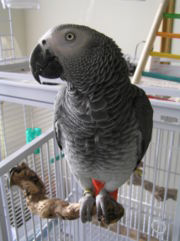 The African Grey Parrot is a medium-sized parrot of the genus Psittacus native to Africa, and is considered one of the most intelligent birds. As their name implies, they are predominantly grey, with accents of white. They feed primarily on nuts and fruits, supplemented by leafy matter. The African Grey Parrot is around 33 cm long.
The African Grey Parrot is a medium-sized parrot of the genus Psittacus native to Africa, and is considered one of the most intelligent birds. As their name implies, they are predominantly grey, with accents of white. They feed primarily on nuts and fruits, supplemented by leafy matter. The African Grey Parrot is around 33 cm long.
There are two subspecies:
• Timneh African Grey parrot, Psittacus erithacus timneh: these are smaller in size, have a darker charcoal gray coloring, a darker maroon tail, and a light, horn-coloured upper mandible. A Timneh is often called a “TAG”.
• Congo African Grey parrot, Psittacus erithacus erithacus: these are larger birds (about 12 inches/30cm long) with light grey feathers, cherry red tails, and black beaks. A Congo is often called a “CAG”.
While comparative judgments of animal intelligence are always very difficult to make objectively, Psittaciformes are generally regarded as being the most intelligent of birds. African grey parrots are particularly noted for their cognitive abilities, believed to have evolved as a consequence of their history of cooperative feeding on the ground in central Africa.
African Greys require plenty of stimulating toys to keep them from becoming bored while confined to their cage. These toys need to be rotated and switched out regularly in order to maintain the bird’s interest. African Greys have special dietary requirements, and should be fed plenty of foods rich in calcium and Vitamin A — such as almonds, small amounts of cheese, or leafy greens including mustard greens, broccoli, etc. It is usual to give African grey parrots carefully calculated quantities of calcium and vitamin supplements. An excess of these added vitamins and minerals in an African Grey’s diet can lead to health problems. African Grey parrots’ lifespans are up to about 60 years, or more, in captivity.
African Greys require plenty of stimulating toys to keep them from becoming bored while confined to their cage. These toys need to be rotated and switched out regularly in order to maintain the bird’s interest.
It is very important to make sure that African Greys get enough mental  stimulation. They are a very intelligent bird can not only mimic human speech, but some have been able to effectively communicate. Many owners and some studies suggest that Greys (and other parrots) don’t just mimic but can use words learned in new combinations to convey new wants, needs and desires. Alex, a famous Grey that has been studied for years by Dr. Irene Pepperberg, invented the term “long yellow” to express his desire for more corn on the cob. A European study found Greys to have the intellectual capacity of a 5-year-old human child with the emotional development of a human 2 year old (read as terrible two year
stimulation. They are a very intelligent bird can not only mimic human speech, but some have been able to effectively communicate. Many owners and some studies suggest that Greys (and other parrots) don’t just mimic but can use words learned in new combinations to convey new wants, needs and desires. Alex, a famous Grey that has been studied for years by Dr. Irene Pepperberg, invented the term “long yellow” to express his desire for more corn on the cob. A European study found Greys to have the intellectual capacity of a 5-year-old human child with the emotional development of a human 2 year old (read as terrible two year
As with any parrot there is no guarantee that an African Grey will talk. Talking ability should not be the only reason a particular parrot is chosen. Congo African Greys – are known to be shy around strangers, and tend to bond solely with their main caretaker if they do not interact with different people regularly.









